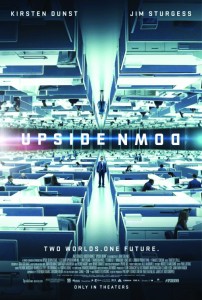Last week was a medium-to-heavy stressful haze of completing one project only to realize that I had another due. My roommate and I decided it was high time we just give up and find a potentially emotionally taxing movie to watch in order to have an excuse for the release of our tears of desperation. We settled on Upside Down, a 2012 release written and directed by Juan Solanas. We chose Upside Down for a two reasons. First, because of its stars. The movie features Jim Sturgess of Across the Universe and 21 fame, and Kirsten Dunst, who is quite possibly my most favorite actress. Our second reason was the intriguing premise.

Solanas crafted a world in which two planets rotate together mere yards apart, each with their own separate gravity. Matter from one planet maintains its own gravity on the other planet, thus making it impossible for humans to walk on the opposite planet. The planets are connected by a skyscraper housing TransWorld, a company that governs interplanetary contact and commerce. “Up Above” is the affluent planet. “Down Below” is the impoverished planet. As my roommate put it, “This is a very obvious metaphor for the Global North and South.”
As you might expect, Sturgess and Dunst play Adam and Eden, citizens of Down Below and Up Above, respectively, who meet by chance on twin mountaintops and fall in love. And so unfolds a classic forbidden love story, following the struggles of two people separated by class, distance, and in this case, gravity.
For the first half of the movie, all was well. The dual worlds kept the otherwise mundane plotline interesting. The cinematography was beyond stunning. Picture for yourself the possibilities: simultaneous sunsets and sunrises, mirrored horizons, the stark and beautiful contrasts between the gleaming Above and the ashen Below. All of these images and more were fantastically represented in this imaginative landscape. It was truly stunning to watch. The score, too, was amazing. Instrumentals by a variety of composers accompanied the cinematography. It was almost enough to watch the movie just for those two elements. Almost.
Unfortunately, as the movie progressed, several faults became more and more obvious. Dunst’s considerable talents were wasted in a role that reduced her to little more than the damsel in distress. Eden’s scenes were short and all but one or two were merely flirtatious conversations with Adam. Sturgess plays a lovably optimistic Adam, however, who was the main focus: a visionary inventor blindly using his skills to pursue the ever-elusive Eden rather than to improve the standard of living in his police-state planet.
Various plot holes grew and grew until they basically bottomed out during the clearly rushed conclusion. It’s not too much of a spoiler to say that somehow, miraculously, the star-crossed lovers are finally brought together through an unexplained turn of events. The film concludes with glossy pans of an economically balanced future, with children from both Above and Below happily playing together on the same plane. This change is apparently sparked by the romance between Adam and Eden, although the hows and whys of it are never delved into.
Overall, Upside Down would have worked much better as a short story rather than a feature-length film. While I give the actors involved props for making their performances memorable even with limited material, I don’t suggest watching this film unless you are just really, really, really into cinematography.
